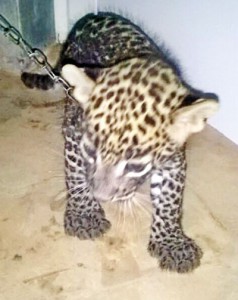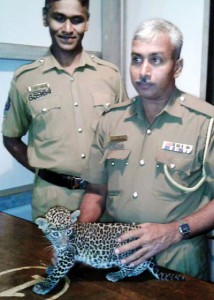News
Sri Lankan wildlife plunder continues to be driven by the underworld

The leopard cub found in the posession of a 16-year-old in Mannar. Pic by Romesh Madushanka
Pangolin, the world’s most trafficked mammal, is a delicacy in China, Hong Kong, Taiwan and in countries where Chinese live. This ant-eating creature’s scales are highly valued by Chinese and Vietnamese. Chinese and Indians are among those arrested for illegal smuggling of pangolins from Sri Lanka over the years.
This highly-organised, multi-billion-dollar illegal trade in wildlife by criminal gangs is also being fed by Sri Lankans who are keeping various species endemic to the island as pets. A senior official of the Department of Wildlife Conservation warns they are on the wrong side of the law.
Just this week, a 16-year-old student was charged with the possession of a leopard cub (panthera pardus kotiya) at Vetteyarmurripu near Thirikeshvishwaram in Mannar. Complaints last Saturday about a missing cow led police to the teen. Sergeant Sunil Bandara Kulathunga said two 15-year-olds and a 16-year-old boy were suspects. A leopard cub was found in the possession of the 16-year-old. He had claimed that the cub had been found in a tree hole.
Mr Kulathunga said inquiries revealed that the teens had been hunting animals near Kandal Junction “Nayatta veli’’ with dogs. They had also consumed the meat of monitor lizards and other small mammals.
The boy was charged at the Mannar Magistrate’s Courts with illegal possession of a wild animal and was released on Rs 50,000 surety bail. He will reappear in court on January 11, 2017.
The leopard cub was handed over to the Madhu wildlife office. An official there said the cub was treated by the Anuradhapura Wildlife Veterinary Division. The vet, Dr Chandana Jayasinghe, said the cub was a female and suffered from nutrition deficiencies and was dehydrated.
Meanwhile, the wildlife official said that over the years they had detected individuals keeping pets to supply the illegal trade. In nine raids they detected two types of coral, 61 sea snails, several boxes of dead butterflies, star tortoises, 17 soft shell turtles, black turtles, parrots, mynas, Sri Lankan hill mynas, and giant squirrels.
In the most recent raid in Ja Ela, officials found 17 horned and leaf-nosed lizards.
He said organised crime networks are at the heart of the illegal wildlife trade. Sri Lankan wildlife is protected under the Fauna and Flora Protection Act. There are also customs laws.

Part of the police contingent who made the raid
“According to the Act anyone who attempts to hurt, injure, capture, smuggle, or erect traps, face penalties including fines and imprisonment,” he said. “If protected mammals or reptiles are held captive, a suspect faces a minimum fine of Rs 30,000 and maximum Rs100,000 fine, or a jail term of two to five years. For protected species, the fine will be between Rs 20,000 and Rs 40,000 with two to five year jail terms. Those illegally keeping amphibians can be fined Rs 15,000 and face a jail term of two to five years,’’ he said.
He said the Sri Lankan soft shell turtle, black turtle, and the star tortoise are valued as pets, while there are those who relish their meat. These tortoises are also sought-after overseas. Endemic birds, fish, amphibians and insects are also sought by the exotic pet trade that is helping to plunder Sri Lanka’s wildlife at will.
The Sunday Times learns that most endangered animals are found in the wet zone but that wildlife offices are located in the dry zone. There aren’t enough wildlife rangers also.
The wildlife official explained that the slender loris, leopard, jungle cat, rusty spotted cat, fishing cat, Eurasian otter, Indian pangolin, barking deer are among creatures for which there is a big demand.

